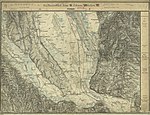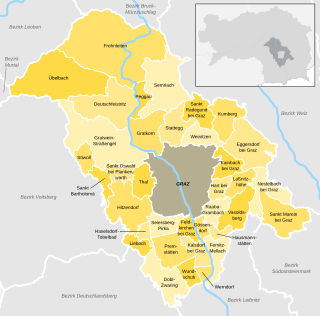
Bezirk Graz-Umgebung is a district of the state of Styria in Austria. It forms a continuous ring around Graz, the capital city of Styria and also the seat of the district commission.

Dobl was a municipality in Austria which merged in January 2015 into Dobl-Zwaring in the Graz-Umgebung District of Styria, Austria.

Zwaring-Pöls was a municipality in Austria which merged in January 2015 into Dobl-Zwaring in the Graz-Umgebung District of Styria, Austria.
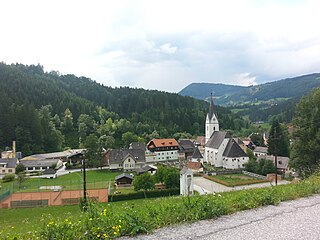
Geistthal-Södingberg is, since the beginning of 2015, a municipality within Voitsberg, Styria. The municipality of Geistthal-Södingberg was created as part of the Steiermärkische Gemeindestrukturreform in Styria, which combined Geistthal and Södingberg.
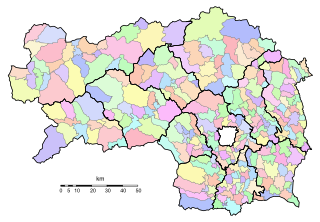
The Styria municipal structural reform was a local government reform in the Austrian state of Styria, which was made effective January 1, 2015. The reform nearly halved the number of Styrian municipalities from 542 to 287. The reform was intended to reduce costs and ease election of new town officials. The terms of the reform is formalized in the Styrian Municipality Structural Reform Act. (StGsrG). The law was adopted on December 17, 2013 by the Landtag of Styria, and promulgated on April 2, 2014.
Raaba-Grambach is a market town in the district Graz-Umgebung in Styria, Austria since 2015. It was created as part of the Steiermärkische Gemeindestrukturreform of Styria at the end of 2014, dissolving the towns Raaba and Grambach. One complaint from both communities against merging was raised at the Constitutional Court but ended unsuccessfully.

Aflenz is since January 2015 a new market town with 2,421 residents in Bruck-Mürzzuschlag District of Styria, Austria.
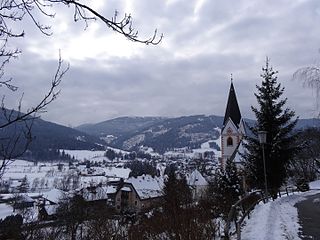
Sankt Georgen am Kreischberg is since 2015 a municipality in Murau District in Styria, Austria. It was created as part of the Styria municipal structural reform, out of the former independent towns Sankt Georgen ob Murau and Sankt Ruprecht-Falkendorf. The town church after the changes, which began in November 2013, had continued the name "Sankt Georgen ob Murau", which was corrected through an amendment in April 2014.
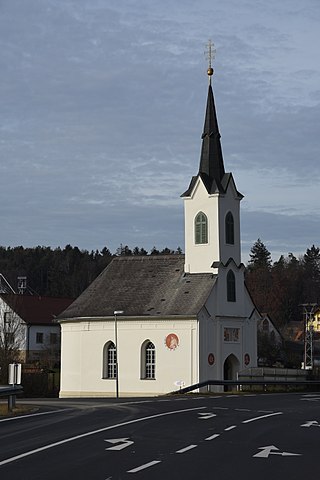
Kirchbach-Zerlach is since 2015 a municipality with 3,271 residents in the Südoststeiermark District of Styria, Austria. In 2015 the municipality was called Kirchbach in der Steiermark.

Fernitz-Mellach is since 2015 a municipality with 4,654 residents in Styria, Austria. It lies in the south of Graz-Umgebung District. The municipality was founded as part of the Styria municipal structural reform, at the end of 2014, by merging the former towns Fernitz and Mellach.

Feistritztal is since 2015 a municipality in Hartberg-Fürstenfeld District in Styria, Austria.

Ehrenhausen an der Weinstraße is a municipality with 2,623 residents in the Leibnitz District of Styria, Austria.

Irdning-Donnersbachtal is a new municipality since January 2015 with 4,137 residents in the Liezen District of Styria, Austria.

Leutschach an der Weinstraße is since January 2015 a new municipality with 3,794 residents in the Leibnitz District of Styria, Austria.
Premstätten is since January 2016 a new market town with 5,784 residents in Graz-Umgebung District of Styria, Austria. However, it was previously founded in January 2015 as the town name "Unterpremstätten-Zettling".

Mitterberg-Sankt Martin is a municipality since 2015 in the Expositur Gröbming in the Liezen District of Styria, Austria.

Pöls-Oberkurzheim is a municipality since 2015 in the Murtal District of Styria, Austria.

Sankt Veit in der Südsteiermark is a municipality since 2015 in the Leibnitz District of Styria, Austria. The population was 4,069 residents.
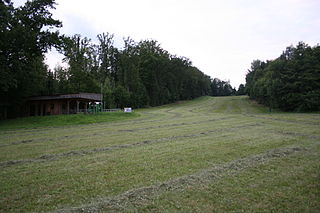
Seiersberg-Pirka is a municipality with 12,112 residents, and after Gratwein-Straßengel, the 2nd-largest municipality of Graz-Umgebung District in Styria, Austria.

Stadl-Predlitz is a municipality since 2015 in the Murau District of Styria, Austria.







